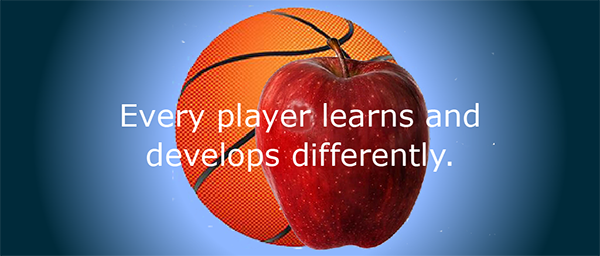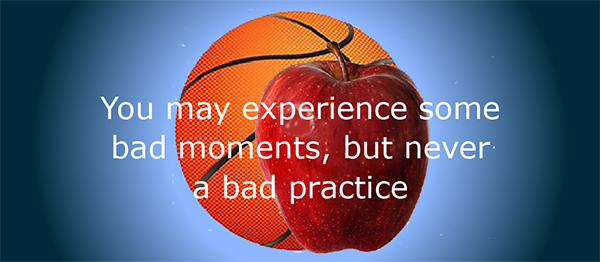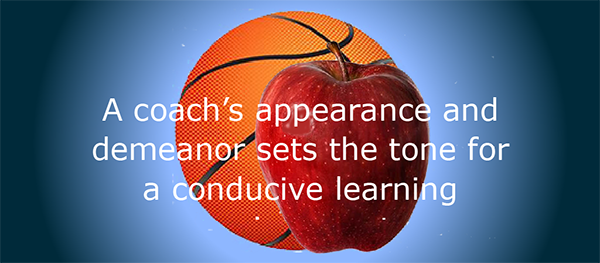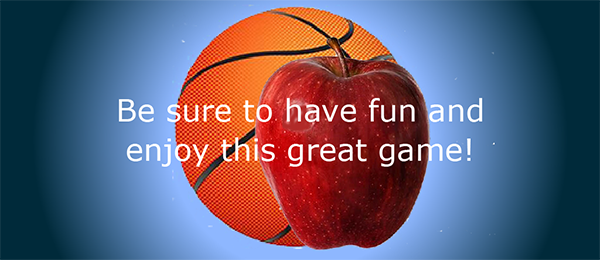Player Learning
The Art of Teaching Basketball
What you will discover or recall:
Types of Learners
Learning is Best When
What coaches can do to improve learning
Coaching Success
Individual Learning Styles

There’s no one size fits all when it comes to learning. In fact, everyone is different. However, there are four common types of learners. To be successful in teaching basketball skills, coaches must be cognizant and utilize all four of these learning techniques:
- Visual. Visual learners best comprehend information by visualizing relationships and ideas. They learn by seeing.
- Auditory. Auditory learners are all ears. They learn by hearing.
- Kinesthetic. Kinesthetic learners learn physically by doing and exploring. They learn by feel or touch.
- Written Word. Written Word learners learn by reading and writing. They learn by reading.
Coaches are responsible for making learning interesting, relevant and fun. However, with the current emphasis on games and winning rather on player development and skill learning, the vast majority of players today are having bad experiences with coaches and basketball. This is a real problem. It is mainly the result of basketball coaches not being adequately trained, certified, and accountable.
Since players mature and develop at different rates, it is best to group young players by maturity and experience rather than by age. In addition, most “Bigs” require extra work and patience since they do not become productive until college age.

Learning is definitely enhanced when:
- The coaching staff is enthusiastic, well versed and knowledgeable.
- The physical and social environments are conducive to learning.
- It is appropriate to the emotional and physical maturity level of the players.
- It involves strong support and encouragement (under-achievers will excel on occasions, while the talented are consistent).
- It includes activities using as many senses as possible. Learners remember 10% of what is read, 20% of what is heard (75% is forgotten after 2 days), 30% of what is seen (majority of learning), and 50% of what is heard and seen.
- It is sequential and logical, progressing from concrete to more abstract concepts (one on one skills before five on five skills).
- It involves activities that are appropriate to the specific situation. The best way to LEARN basketball is to PRACTICE basketball.
- It is purposeful and fully understood by the learner (boxing out on rebounds).
- It is the result of functional understanding. Players must gain a working knowledge of the game (what, when and why should be very clear and specific).
- It involves constant repetition and practice using correct techniques.
- It encompasses the teaching of cognitive (knowledge), psychomotor, and attitudinal (confidence) skills to develop the complete player. Attitudinal skills are the toughest to achieve.
. . . when it is FUN!
.
What Coaches Can Do to Improve Player Learning

1. Get off on the right foot. Greet and welcome every player daily with enthusiasm. “Another great day for basketball.” Players should feel welcomed and anxiously look forward to practices. This is especially true for young or beginning players.
2. On every level of basketball, one of the most important aspects of coaching is creating and fostering a total team atmosphere and commitment. It is the difference between success and failure.
- Insure your players that they are going to play in a team atmosphere. Inform your players that you are not going to tolerate anyone on the team that keeps others from learning, you from coaching, or any other misbehavior.
- Great teams are a result of the best players being the hardest workers.
3. Do your homework. Practices should be well organized and planned. Every drill must have value or purpose otherwise throw it out. Alternate physically tough and easy drills. Include individual work in each practice.
- Be sure to teach WHEN and WHILE as well as the HOW. There are certain fundamentals every player must master and, in addition, each position also has specific fundamentals to learn.
- Don’t expect players to know or execute anything that has not been covered in practice.
- During a game, if a situation arises for which they are not prepared, take note and address it in the next workout rather than trying something new during a game.
4. Develop all your players to the best of their capabilities. Coaching great players is easy. Where great coaches excel is in getting the most out of every player on the squad regardless of physical abilities and skills.
- Establish significant roles and assignments for every player on the squad such as 6th Person, Defensive Stopper, and Designated Inbounder.
- These roles are vital to a total team effort. They must be constantly acknowledged and reinforced by the entire coaching staff throughout the season.
5. It is imperative that anytime a coach speaks that everyone listens including other coaches. Demand and get eye contact of all players prior to speaking.
- Do not get caught up with lengthy explanations.
- Use constructive criticism when appropriate, but never yell. Have you ever heard of a successful teacher that yells at their students?
- Set an example. Never use profanity. Educated people can clearly express themselves without the use of profanity.
6. The importance of “Early Time,” the time when players arrive until practice actually begins, cannot be over emphasized. This 20 to 30 minute period allows for players to arrive and mentally prepare for practice. This is especially needed, when players have to travel to practice.
- Although, most coaches tell their players to use this time wisely and work on individual skills; in reality, most of this early time is spent socializing.
- It is the foundation of a successful workout. Early Time does not only prepare players physically, but more importantly, it puts them in the right frame of mind. With a proper use of early time players will be able to better concentrate, understand, and learn. As a result, more will be accomplished much more during the ensuing practice.
7. Clarify rather than confuse. Do not over coach. Keep instructions simple. Teach using quick mental terms. Associate a technique with a name by using one syllable words such as “Ball”, “Shot”, “Down”, “Push”, etc. Make sure that the coaching staff use the same offensive and defensive terminology.
Point out and commend good efforts and actions rather than negative ones. During each practice, point out and recognize something positive for every player. Be sure to always use players’ first names when pointing out a positive efforts or actions. It gives them a feeling of pride and recognition.
8. Use “I” & “I” psychology (Isolate & Ignore). When a player misbehaves or is not giving their best effort, just send them to the showers. The worst punishment for a basketball player is to deny them participation. In denying participation, it encourages and promotes good behavior and effort. If the entire team is not working hard, send the entire team to the showers. They will get the message.
9. The game within a game. Make individual development and improvement an integral part of every practice. Provide each player with a list of individual skills to stress and improve on during the practice.
- The specific skills will vary from player to player and can be assigned by the coaching staff or determined by the players themselves.
- As a reminder, the skill(s) should be written on a 3 X 5 card and given to each player prior to practice.
- Individual skill development may take several practices to achieve.
10. Make drills competitive and challenging. Turn punishment motivation into reward motivation. For example: “One & One and Run” free throw shooting drill commonly used to practice free throws under pressure.
- Using Negative or Punishment Motivation: If a player misses the first free throw of the One & One bonus situation, they run a set of lines. If they miss the second free throw, they run the length of the court. If they make both free throws, they just get to go to the end of the line.
- Using reverse psychology and competition turn Punishment motivation into or Reward Motivation: If a player misses the first free throw, they just go to the end of the line. If a player makes the first free throw but misses the second, they run the length of the court. When they make both free throws, they run a set of lines. The first player to run 10 sets of lines wins! The rest of the players (losers) have to do ten pushups.
- In the first punishment scenario, poor free throw shooters spend most of the time running (conditioning) while the good free throw shooters just shoot. In the second reward scenario, the good free throw shooters run (condition) while the poor free throws shooters practice shooting.
11. Motivate the defense during scrimmages by requiring the defense to make a certain number of defensive stops (combination of defensive rebounds, steals and turnovers) in order to go to offense.
- This will encourage and motivate the defense to play hard.
- In practicing against tough defense, it will definitely better prepare the offense for actual games.
- Practicing against a weak or dummy defense is detrimental to game preparation.
12. End all practices on a high note or successful achievement such as a made pressure free throw, shooting contest, or a made half court shot. Be sure to review what was learned or emphasized along with what will be covered in the next practice.
Coaching Success
The real success in coaching does not come from winning. It comes with the teaching and assisting ALL of your players to become the best they are capable of becoming “On” and “Off” the court. The time they spend with you should be a lifelong, rewarding and positive experience. Too many players are having bad experiences with coaches.
To Learn More About Motivation & Learning – Click Here

.

_____________________
Coming Next:
Motor Skill Learning
_____________________

| #1 | Coaching, Life Skills, Keys to Success | Tap Here to View |
| #2 | Legal Liabilities | Tap Here to View |
| #3 | Major Medical Emergencies | Tap Here to View |
| #4 | Motivation & Learning | Tap Here to View |
| #5 | Player Learning Styles | Tap Here to View |
| #6 | Motor Skill Learning | Tap Here to View |
| #7 | Game of Habits | Tap here to view |
| #8 | Changing Bad Habits | 8/18/2020 |
| #9 | Goal Setting & Season Review | 8/25/2020 |
Posted: July 28th, 2020 under Coaching Strategies | Player Development.
Tags: Coaching, Learning, Motivation, Practice, Skills, Teaching
Comments: 1


